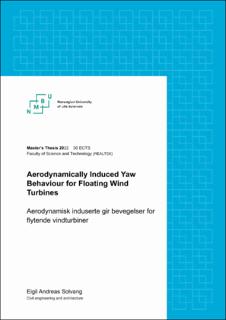| dc.description.abstract | The demand for more renewable energy grows stronger by the day. The world is experiencing more pollution and environmental damages from human activity than ever
before. One of the possible solutions to produce more sustainable energy is offshore
wind energy, more specifically floating wind energy. When transferring wind turbines
to the sea, far from shore, they will be less intrusive on society as well as the wind is
stronger and more constant.
This thesis dives deeper into the aerodynamically induced yaw motion of a wind turbine
floater. It also attempts to explain the underlying physics based on wind direction, wind
speed and yaw stiffness provided by the mooring lines.
To describe the fundamental mechanics, a static yaw system based on wind directions
and rotor plane-angle for a wind turbine floater is presented. To find the combination
of wind directions and -speed that causes large yaw rotations, numerical time-domain
simulations are conducted in SIMA. A model of the INO WINDMOOR 12 MW turbine,
using a semi-submersible floater is used in the study. This floating wind turbine is
subjected to constant wind intensity with varying wind speeds and wind directions.
This numerical study consists of two approaches: one analysis with a rotating floater,
where platform yaw has been the output parameter, and one analysis fixing the floater
and calculating the platform yaw moment based on internal forces. The internal forces
are generated by the thrustforce acting on the turbine. Platform rotation and platform
yaw moment is then matched and compared by using a non-linear mooring stiffness
curve.
From the simulations it was observed a quite good correlation for the platform yaw
between the two analysis for wind speeds in the operational domain (0-25 m/s). For
wind speeds above 25 m/s, in the idling phase, a larger deviance was observed. The
rotating floater experienced large rotations for some wind directions when subjected to
an extreme case of 45 m/s. The fixed floater on the other hand, was unable to capture this self-reinforcing unstable yaw effect, which was observed for the rotating floater. | |
